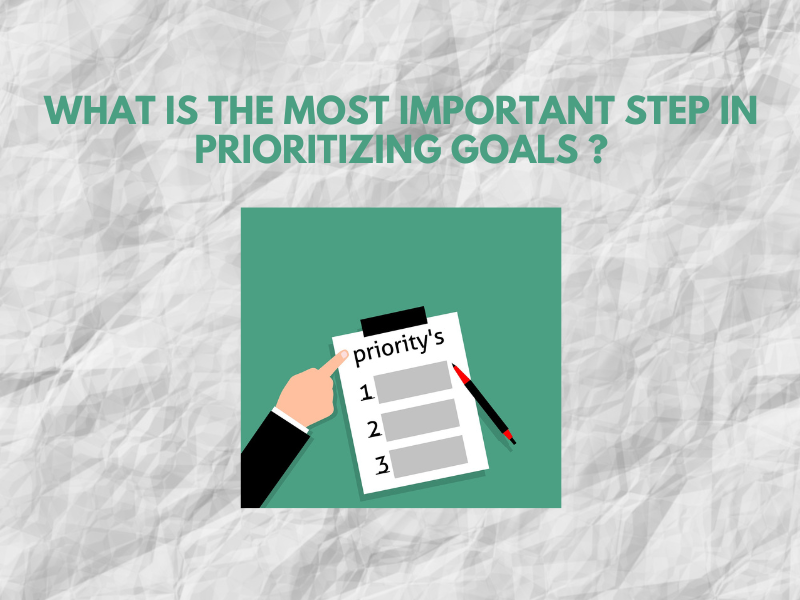What is the most important step in prioritizing goals? People often ask themselves this question, but finding the answer can be difficult.
When prioritizing goals, there are so many factors to consider, including time constraints and resources.
The purpose of this blog post is to explore some of the steps involved in goal prioritization, as well as determine which one is the most critical.

Among the topics, you will cover goal setting, defining your goals, prioritizing them, the importance of prioritizing goals, different techniques, and methods, as well as maintaining focus to achieve your goals.
Especially if you’re a new start-up entrepreneur trying to manage important tasks and time management efficiently, make sure you don’t miss anything.
In addition, this post can be helpful to leaders, project managers, officers, and anyone else out there.
Let’s Discuss the Question, “What is the Most Important Step in Prioritizing Goals ?”
When aspiring to be successful, you should ask better questions, and, as a result, you will find meaningful answers.
Similarly, if any successful leader or influencer in your life asks, “What is the most important step in prioritizing goals?” I suggest you start from the very beginning.
So let’s begin by defining goals and priorities.
Goals
A goal is a term used when any individual or organization wants to achieve something, such as deciding to reach a certain level or status while making your business highly productive.
Goal setting is an idea for a future desire that an individual or group works hard toward.
They make plans and make promises to achieve the goal they set. And people set deadlines to achieve those goals within a specific time frame.

For example, someone may set the goal of leading the organization to success and earning enough money to purchase a piece of their old age because the most precious thing in life is a peaceful time.
According to such an example, you set a financial goal with time management. But goals should be realistic; only dreaming can not be considered a goal.
Priorities
Making something a priority indicates that you are highly focused and enthused about achieving something. It accelerates your progress toward your desired level.
By prioritizing goals, you prioritize the most specific goal-setting and create an actionable plan to complete that task.
Setting goals and prioritizing your tasks will assist you in staying on track and motivated.
When people successfully achieve a specific goal, their priorities shift. They set new goals and again work on the prioritization method.
But remember always to plan an offensive strategy. It gives you a warm feeling that gives your mind a sense that you will not fail.
Prioritization provides a sense of control as if you are the master and commander of your divine.
Why is Goal Prioritization Important for You?
Goal prioritization is critical in achieving success because it allows you to focus on the specific task lists that are important to you.
It works amazingly well because it drives your business to productivity with efficient time management.
In the recent era. Some people believe that time is as valuable as money and that our attention is equally valuable.
You are easily captured by activities that are complete time sinks for you.
Goal Prioritizing is a powerful method that ensures you run toward a productive goal instead of wasting your time and energy.
Effective prioritization allows you to be more productive, goal-oriented, proactive toward achieving goals, and motivated.
What is Goal Prioritization?
If you come across someone in your life who devotes all of their time and energy to achieving a specific professional goal, then he is the perfect guy for the organization.
On a more serious note, it is extremely rare. Normally, your mind is filled with goals and things you want to accomplish.
The list can never be too short. It is not a new phenomenon that most employees must deal with competing priorities when they have multiple tasks to complete because they are all important.
You devote each day to a productive job, reporting to the boss, so many projects require your attention, and so on. to deal with this competing priority, you just work on time management and set a list for goal prioritization.
On the other hand, Prioritization is the process of organizing and arranging the things that are important to you.
Most successful people believe that doing things this way allows you to focus on the most important tasks while avoiding getting bogged down in less important ones.
How would you measure your progress toward your accomplishments and set goals if you didn’t work on prioritizing goals?
And yes, it is not merely useful for companies and entrepreneurs; it can work fantastically in all aspects of life.
Though there are many different ways to prioritize goals, the most useful method is to narrow down a list of task characteristics and create a goal-setting hierarchy to prioritize goals based on urgency, importance, and values.
Following these guidelines, you create a list of your goal hierarchy, ranking them from most important to least important.
However, you must consider the factors influencing achievement and the required time in this case.
The Eisenhower Matrix is a mighty common tool for goal prioritization. This tool allows you to prioritize your goals based on urgency, importance, and values.
A more in-depth examination of the Eisenhower decision matrix will help you because it tells you how to prioritize the goals that lead to higher success.
Prioritizing Goals: Proven Techniques
The Eisenhower Decision Matrix: Now Prioritize Goals Based on What’s Most Important
An extremely simple decision-making tool commonly used is the Eisenhower decision matrix. You can use this simple matrix to determine whether a task is important or unimportant and whether it is an urgent task.
You can benefit from quick techniques for evaluating multiple goal options to make wise decisions and implement the right action.
Let’s take a look at Eisenhower’s decision matrix:
The Eisenhower matrix divides the task list into four boxes where you can enter information according to importance and urgency.
It is also known as the Urgent-Important Matrix. In his best-selling book, “The 7 Habits of Highly Effective People, ” Stephen Covey presented this popular matrix.”
In the 7 Habits of Highly Effective People, ” Stephen Covey presented this popular matrix.”
Using this simple matrix, you can sort out the meaningful and critical priorities in any aspect of your life or delegate or delete less important tasks from the list.
Increase Your Productivity through Warren Buffet’s 5/25 Rules
You’ve probably heard of one of the most successful investors in recent history, worth $102 billion at the age of 92.
Yes, he is none other than Warren Buffet. the wise businessman Warren Buffet gives us 5/25 rules for living a productive life with less time and energy.
He said his rules help you come out of stress when you are stuck with many important goals that need your time, focus, and attention.
5/25 rules is a productivity method based on three simple but important steps.
Make a list of your 25 most crucial career goals.
Mark five highly crucial goals that truly matter to you because these are highly urgent goals that need all your attention.
Remove the remaining goals from the list.
Buffet believes that the remaining 20 goals are unimportant to him. And putting forth any effort or investing time or money is a waste.
These rules are mostly used for career goal accomplishments but are also very important for family goals, professional goals, personal goals, etc.
In short, these steps are simple and practical for prioritizing goals in all aspects of life.
One thing is certain: Buffet has made some wise decisions that have elevated him to the highest echelons of society.
So, his rules are very obvious and should be taken seriously. However, nothing can be perfect in every situation. There is no leeway in the buffet’s rules.
You must prioritize five important things in your life and say bye to the rest unless you fulfill the first five. This process can bring you much closer to your set goals.
Use the Pareto Principle to Prioritize Tasks
Vilfredo Pareto was an Italian economist. In 1896, he devised the 80/20 rule. According to the economic situation, he states that an 80% outcome results from only 20% effort.
It means that a very lean percentage can have a large effect.
We are discussing this wealth distribution concept here because it can help us understand and identify the most important priorities that have a huge impact.
This 80/20 rule is commonly known as the Pareto principle.
When you apply this concept to goal setting and prioritizing, you should concentrate on goals that lead to the most relevant outcomes—And disregard the unimportant and irrelevant.
However, to implement this on your map, you must list 25 goals of greater importance to you (just like buffet rules).
But here, you don’t need to erase the other 20 goals; instead, think about the main goals that can help you attain the most achievements.
How to Use 80/20 Rules in Your Life?
Pareto’s 80/20 rule is used in almost every industry. The Pareto principle benefits businesses and economists in particular.
Because it can greatly aid in determining the prioritized goal on which they should focus their attention and effort to gain the most benefit.
You use the Pareto principle to boost productivity by prioritizing the 20% of tasks that produce 80% of the results.
It means you just need to focus on the tasks that have a huge impact and are highly important for them. However, the procedure only involves making a list of tasks and picking the most crucial ones to prioritize daily.
The Pareto principle is helpful in decision-making and also in quality control. Doubtlessly, this 80/20 technique is an incredible tool for goal prioritization that has the potential to simplify lifestyle and, critically, work for every individual.
What is David Allen’s Step for Goal Prioritization?
David Allen is the most influential personality among the leading organizations. He is the creator, bestselling author, chairman of the David Allen Company, consultant, and international lecturer.
He is popular for his foremost expertise in personal and company productivity. Setting priorities is crucial for productivity and effectiveness, according to David Allen.
According to the opinion of David Allen, people found it easy to differentiate between the significant goals and the goals and tasks that could wait.
He suggests that people arrange their goals and tasks in order of importance and value and according to the state of affairs they pass through.
People will sooner understand that task prioritization greatly influences their overall activities and objectives.
However, goal prioritization indicates that highly effective people use their energy, time, and resources more efficiently.
And yes, it is the true way to protect yourself from difficult objectives by focusing on unimportant tasks. This is the most probable issue when you have a long to-do list.
Focusing on the most important thing first and foremost, you can put your effort, time, and attention into the right objective that will lead you to success.
He also advises entrepreneurs and business owners to break down their objectives and goals into pieces and work on them one at a time, depending on the situation.
This way, you begin with the most important and urgent task and gradually progress to the less important tasks.
This will also teach you how to manage difficult objectives with better time management and less use of energy and resources.
However, frequently, priorities get changed. Of course, time and conditions also greatly impact them, so it is recommended that your to-do list be updated over time as a reflection of these changes.
What is Long Term Goals and Short Term Goals
When discussing long-term and short-term goals, both are typically essential for the organization or the life of an individual striving for success.
Having long-term goals means knowing where you’re going and your purpose. On the other hand, short-term goals are part of a larger goal that aids in achieving smaller successes.
Short-term goals are a breakdown of larger or longer-term objectives to make them more manageable and easier to progress toward.
Short-term and long-term goals are especially helpful in project management. There are a lot of ways that can help a project manager.
Such a long-term goal gives a clear vision of what the team is working towards.
Although short-term goals focus on specific and measurable objectives that bring you closer to your long-term goals, long-term goal setting also assists you in prioritizing tasks of high importance.
In contrast, short-term goals prioritize tasks that must be completed in a shorter time frame.
Long-term and short-term goals are important, becoming a great reason for people to be motivated and stay on track.
Both objectives assist you in identifying potential threats and risks to the project in the future.
Three – Method Goal Prioritization Process
Now that you’ve identified four popular techniques for goal prioritization. They all have significance, and many successful people and well-known organizations benefit from them.
However, three methods of goal prioritization also help in definite ways.
1) Write down Your Goal
First, your goal must be realistic, as said above. The next step is to identify your goal and then write it down.
Creating a specific goal can ease your way toward achieving it. Another important thing is that every single task must be achievable—no dreamy or unrealistic chores.
Writing down your goals keeps you motivated and makes it easier to evaluate your progress.
It also aids in answering many questions, such as where you are now and where you see yourself in the future.
2) Examine the Significance, Urgency, and Value
Now it’s time to examine the significance of the task, its urgency level, and what value it can provide toward success.
This way, you can ensure the project’s success while determining where to prioritize your efforts.
However, urgent tasks need your immediate attention to be completed, while those of greater importance may be treated later.
It will just work like the Eisenhower matrix technique.
3) Review and Evaluate your Priorities Promptly
Once you have set a goal and written it down on the list, you can evaluate and reprioritize it regularly.
It also aids in staying focused and on track. In addition, make a list of your daily tasks and mark them as completed regularly.
Final Thoughts
The good news is that if you’re working on multiple tasks, you’ll have goals from various areas and continuously try to achieve a meaningful place in your life.
Then you’re living a meaningful life, which is a good sign.
Now that you know the answer to the question, “What is the most important step in prioritizing goals” you have learned many techniques and methods to prioritize goals.
You can now deal with a difficult situation. You have taken many steps toward success; now it is time to achieve your desired goal.
Stay persistent, determine your goals, and work harder; you will become an unbreakable challenge for others!

